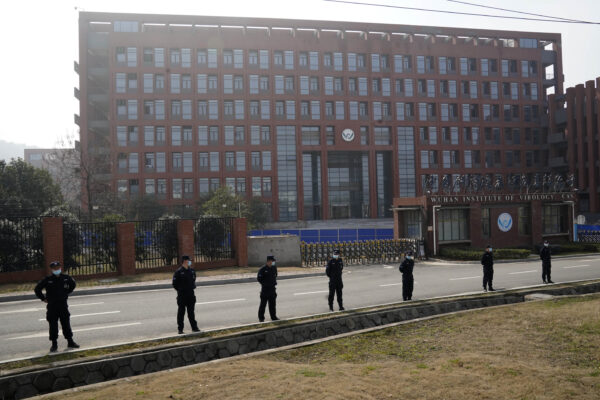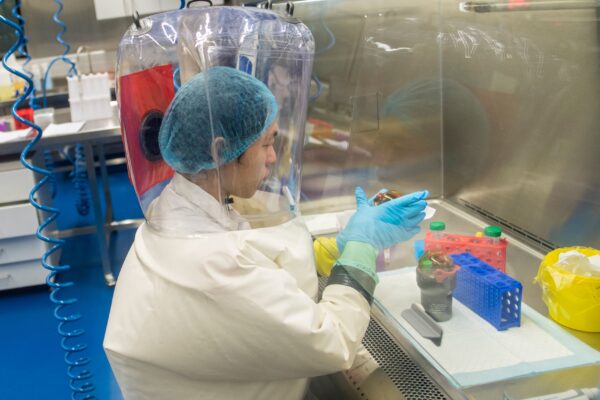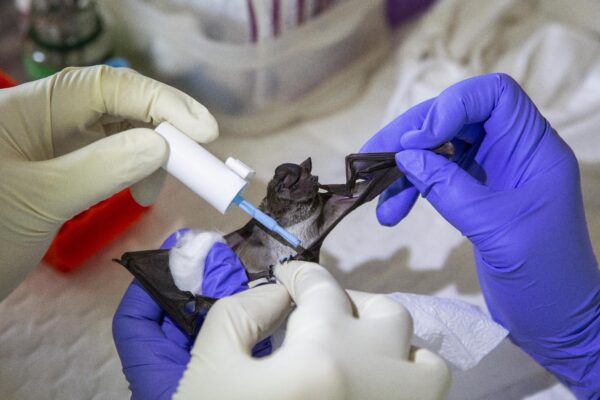
by Nicole Hao at The Epoch Times
The Chinese regime has said its controversial virology institute had no relationship with the military, but the institute worked with military leaders on a government-sponsored project for almost a decade.
The Wuhan Institute of Virology (WIV) participated in a project, sponsored by the National Natural Science Foundation of China (NSFC)—a regime-funded scientific research institution—from 2012 to 2018. The project was comprised of a team of five military and civil experts, who conducted research at WIV labs, military labs, and other civil labs leading to “the discovery of animal pathogens [biological agents that causes disease] in wild animals.”
The WIV is located in central China’s Wuhan City, the COVID-19 pandemic ground zero. As an advanced virology institution, the WIV has the only P4 lab—the highest biosafety level lab—in China and the biggest repository of bat coronaviruses in Asia. The CCP (Chinese Communist Party) virus, commonly known as novel coronavirus, is “96 percent identical at the whole-genome level to a bat coronavirus,” Chinese researchers wrote in a research article (pdf) published in February 2020.
In recent months, the Chinese Foreign Affairs Ministry and Shi Zhengli, the WIV virologist nicknamed “Bat Woman” for her research on coronaviruses of bat origin, denied there is a connection between the WIV and military, and said that no WIV researchers were infected with COVID-19.
However, according to an investigation conducted by the U.S. State Department, “several researchers inside the WIV became sick in autumn 2019, before the first identified case of the outbreak, with symptoms consistent with both COVID-19 and common seasonal illnesses.”
“The WIV has engaged in classified research, including laboratory animal experiments, on behalf of the Chinese military since at least 2017,” states a State Department fact sheet.
However, Shi denied that the WIV engaged in research with the Chinese military. “I don’t know of any military work at the WIV. That information is incorrect,” Shi said at a public webinar on March 23. Shi didn’t mention that the WIV was used by a Chinese military medical team in early 2020 for developing COVID-19 vaccines.
Shi told Science magazine in July 2020 that no pathogen leaks or personnel infections had occurred. The magazine reported that according to Shi, “there is ‘zero infection’ among staff or students with SARS-CoV-2 [2019 novel coronavirus] or SARS-related viruses.”
In late March, overseas Chinese media reported that three WIV staff members started to have symptoms similar to COVID-19 as early as November 2019. Soon thereafter, Chinese state-run media China News reportethat the news was based on rumors.
China News reported that a Chinese specialist told the WHO investigation team—which visited China in February to investigate the origin of the CCP virus—that cases dating back to 2019 were patients at WIV-related hospitals, rather than members of WIV staff.

Security personnel gather near the entrance to the Wuhan Institute of Virology during a visit by the World Health Organization team in Wuhan, China, on Feb. 3, 2021. (Ng Han Guan/AP Photo)
Military-Civil Cooperation
The NSFC put research results about the animal pathogens on its website on Feb. 1, 2018. It also stated that the project “discovered over 1,640 types of new viruses by using the metagenomics technology,” and the research was performed by a civil and military team.
Cao Wuchun, 58, a member of the project’s military team, is a colonel and top epidemiologist in the Chinese military. He has been a researcher at the Academy of Military Medical Sciences since September 2017, but has worked there for the last 21 years. He served as the academy’s director from 2007 to 2017, according to his official resume. Cao served on the team as second in command to Major General Chen Wei, China’s top biowarfare expert.
On Jan. 26, 2020, Cao accompanied Chen to Wuhan and they took over command of the WIV. Chinese state-run media reported, at that time, that the main purpose of the military take-over was to develop a vaccine against the CCP virus.
Cao also co-led the NSFC project with Shi (the WIV virologist), and the Chen-Cao team had taken over the WIV when the COVID-19 pandemic broke out in Wuhan.

Workers are seen inside the P4 laboratory in Wuhan, China, on Feb. 23, 2017. (Johannes Eisele/AFP via Getty Images)
The other three team leaders of the NSFC project were Liang Guodong, Zhang Yongzhen, and Xu Jianguo, researchers from the Chinese Center for Disease Control and Prevention (CDC). Among them, Xu was the project leader or the manager of the other four team members.
Xu, 69, is the director of the CDC’s state key laboratory for communicable disease prevention and control, a scholar at the Chinese Academy of Engineering, and director of the Research Institute of Public Health at Nankai University. Xu’s resume states that he received $987,820 in funding from the NSFC for the project.
As one of China’s top virus specialists, Xu went to Wuhan to serve as a team leader in early 2020. On Jan. 14, 2020, Xu told China’s Science magazine, “All 763 close contacts aren’t infected. The pandemic isn’t severe, and it might stop next week if there’s no more new infection.”
In fact, Wuhan people started to crowd inside hospitals for their pneumonia symptoms from early January 2020, but the regime refused to recognize that the virus can transmit among humans until Jan. 20, 2020. The late announcements fooled people into traveling and allowed the virus to spread all around the world from Wuhan.

A team of scientists and science students from Chulalongkorn University paint the toenails of a wrinkle-lipped free-tailed bat after sampling as a way of tagging it at an on-site lab near the Khao Chong Pran Cave in Ratchaburi, Thailand, on Sept. 12, 2020. (Lauren DeCicca/Getty Images)
Bat Woman
Shi, 56, directs the Center for Emerging Infectious Diseases at WIV. In 2000, she received her Ph. D. degree in virology from the University of Montpellier II in France, after studying there for four years.
Shi started to investigate coronaviruses when China suffered from the severe acute respiratory syndrome (SARS) outbreak in 2002 and 2003.
Beijing authorities said the SARS virus was transmitted from civets (a meat-eating animal) to humans in southern China’s Guangdong Province in November 2002, and spread to other Chinese cities and neighboring Hong Kong because the regime didn’t allow people to discuss this infectious disease in the first two months. SARS eventually killed at least 774 people, and infected 8,096 people from 31 countries.
Chinese state-run CCTV reported on Dec. 29, 2017, that Shi and her team didn’t believe that civets were the natural hosts of SARS, and were only the intermediate host. They started to investigate bats from different Chinese regions in 2004.
In 2011, Shi’s team detected a SARS-like virus from bats living in a cave in southwestern China’s Yunnan Province. They then named this virus “WIV1” and conducted further studies. CCTV didn’t report the details of the virus, but said Shi’s team continued to get samples from the same cave for five years.
Since 2015, Shi’s team has been publishing their test results in international magazines, including Virologica Sinica, Nature, and Lancet.
Weeks after the Chinese regime publicly announced the COVID-19 outbreak, Shi and her team published an article in Nature, linking COVID-19 to bats.
Shi’s team discovered the bat coronavirus in the bats that they had collected from an abandoned copper mine in Tongguan township, Mojiang county in Yunnan Province. The WIV researchers had visited the mine for several days even after six workers had gotten infected while working there.
On July 15, 2020, virologist Jonathan Latham…
Continue Reading